automatic transmission fluid JEEP GRAND CHEROKEE 2013 Owner handbook (in English)
[x] Cancel search | Manufacturer: JEEP, Model Year: 2013, Model line: GRAND CHEROKEE, Model: JEEP GRAND CHEROKEE 2013Pages: 408, PDF Size: 3.21 MB
Page 238 of 408
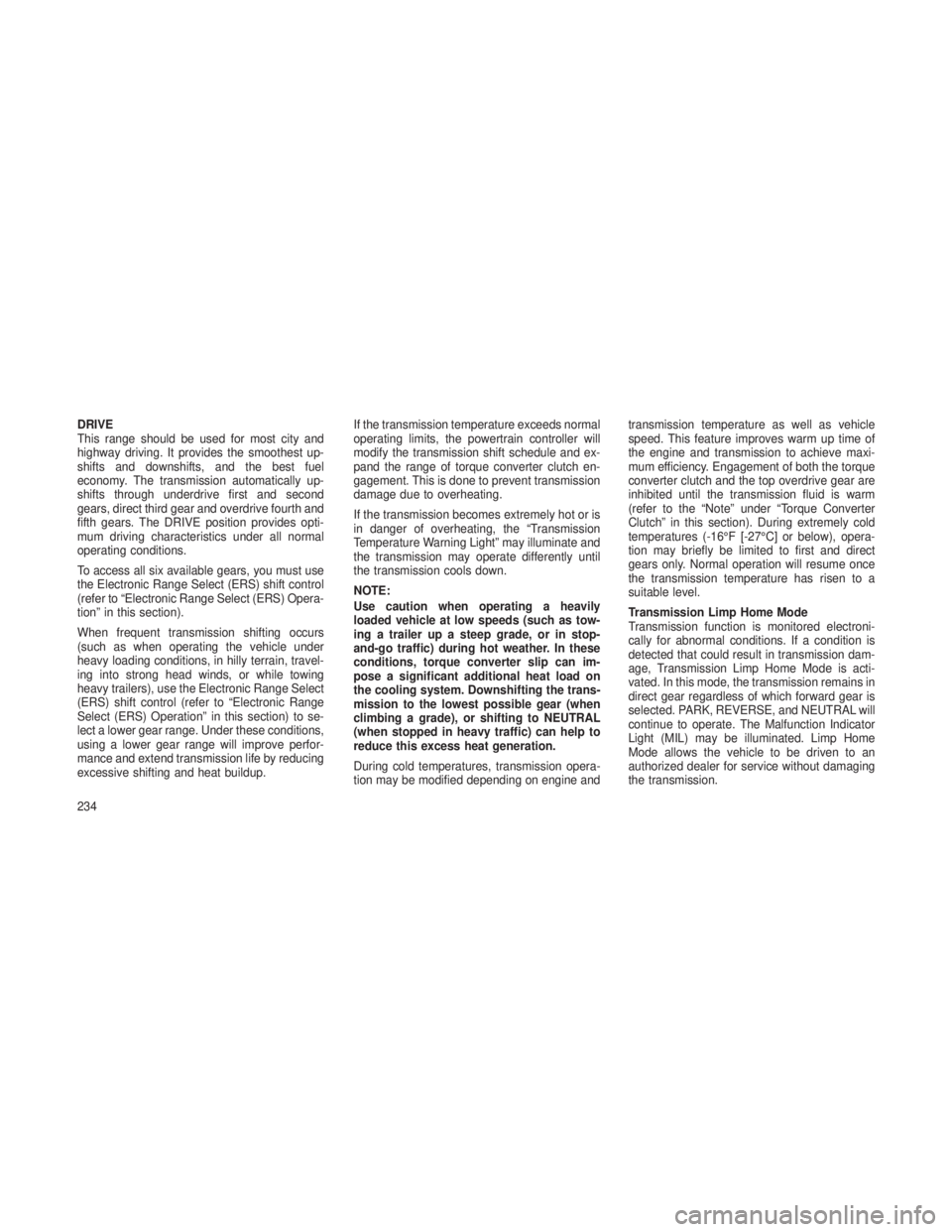
DRIVE
This range should be used for most city and
highway driving. It provides the smoothest up-
shifts and downshifts, and the best fuel
economy. The transmission automatically up-
shifts through underdrive first and second
gears, direct third gear and overdrive fourth and
fifth gears. The DRIVE position provides opti-
mum driving characteristics under all normal
operating conditions.
To access all six available gears, you must use
the Electronic Range Select (ERS) shift control
(refer to “Electronic Range Select (ERS) Opera-
tion” in this section).
When frequent transmission shifting occurs
(such as when operating the vehicle under
heavy loading conditions, in hilly terrain, travel-
ing into strong head winds, or while towing
heavy trailers), use the Electronic Range Select
(ERS) shift control (refer to “Electronic Range
Select (ERS) Operation” in this section) to se-
lect a lower gear range. Under these conditions,
using a lower gear range will improve perfor-
mance and extend transmission life by reducing
excessive shifting and heat buildup.If the transmission temperature exceeds normal
operating limits, the powertrain controller will
modify the transmission shift schedule and ex-
pand the range of torque converter clutch en-
gagement. This is done to prevent transmission
damage due to overheating.
If the transmission becomes extremely hot or is
in danger of overheating, the “Transmission
Temperature Warning Light” may illuminate and
the transmission may operate differently until
the transmission cools down.
NOTE:
Use caution when operating a heavily
loaded vehicle at low speeds (such as tow-
ing a trailer up a steep grade, or in stop-
and-go traffic) during hot weather. In these
conditions, torque converter slip can im-
pose a significant additional heat load on
the cooling system. Downshifting the trans-
mission to the lowest possible gear (when
climbing a grade), or shifting to NEUTRAL
(when stopped in heavy traffic) can help to
reduce this excess heat generation.
During cold temperatures, transmission opera-
tion may be modified depending on engine andtransmission temperature as well as vehicle
speed. This feature improves warm up time of
the engine and transmission to achieve maxi-
mum efficiency. Engagement of both the torque
converter clutch and the top overdrive gear are
inhibited until the transmission fluid is warm
(refer to the “Note” under “Torque Converter
Clutch” in this section). During extremely cold
temperatures (-16°F [-27°C] or below), opera-
tion may briefly be limited to first and direct
gears only. Normal operation will resume once
the transmission temperature has risen to a
suitable level.
Transmission Limp Home Mode
Transmission function is monitored electroni-
cally for abnormal conditions. If a condition is
detected that could result in transmission dam-
age, Transmission Limp Home Mode is acti-
vated. In this mode, the transmission remains in
direct gear regardless of which forward gear is
selected. PARK, REVERSE, and NEUTRAL will
continue to operate. The Malfunction Indicator
Light (MIL) may be illuminated. Limp Home
Mode allows the vehicle to be driven to an
authorized dealer for service without damaging
the transmission.
234
Page 240 of 408
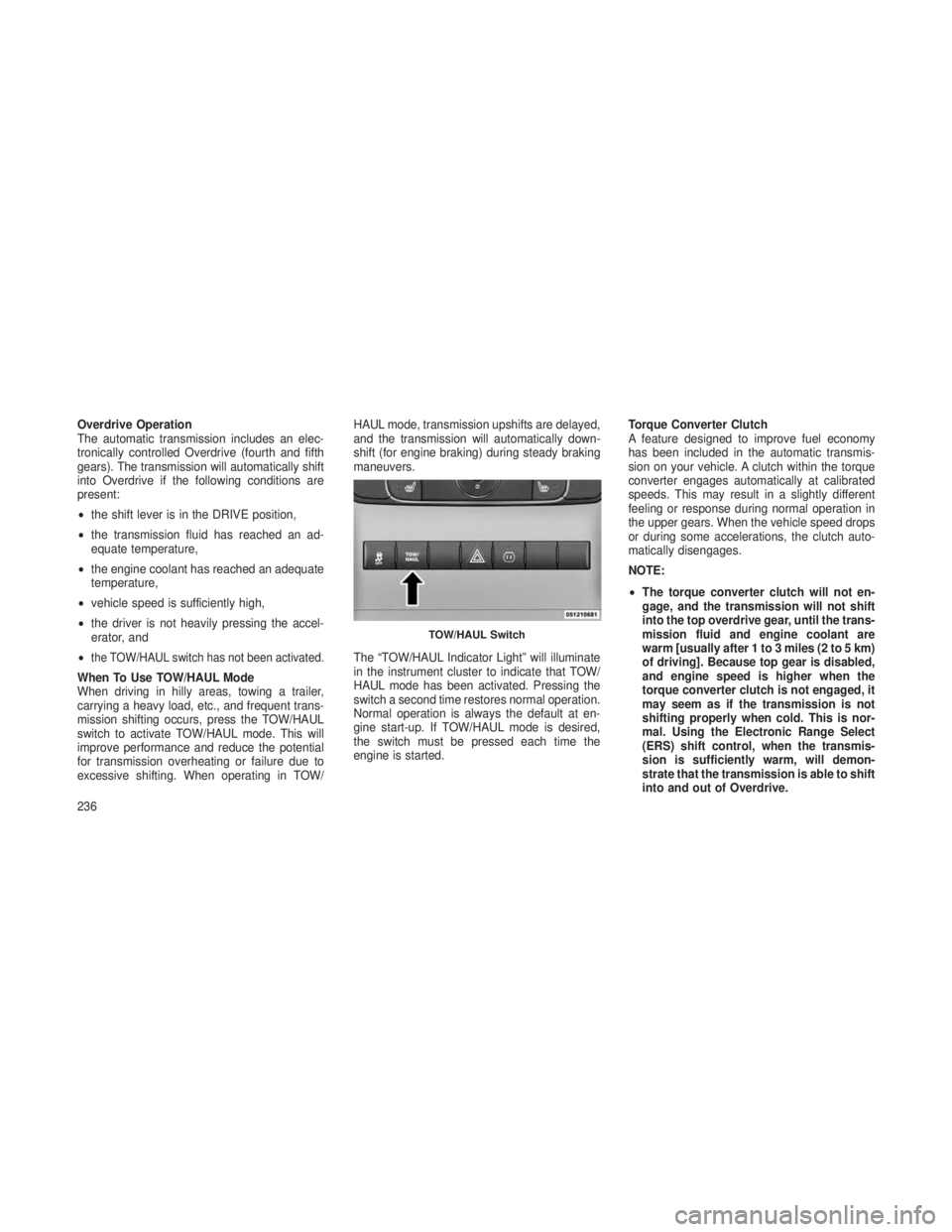
Overdrive Operation
The automatic transmission includes an elec-
tronically controlled Overdrive (fourth and fifth
gears). The transmission will automatically shift
into Overdrive if the following conditions are
present:
•the shift lever is in the DRIVE position,
• the transmission fluid has reached an ad-
equate temperature,
• the engine coolant has reached an adequate
temperature,
• vehicle speed is sufficiently high,
• the driver is not heavily pressing the accel-
erator, and
•
the TOW/HAUL switch has not been activated.
When To Use TOW/HAUL Mode
When driving in hilly areas, towing a trailer,
carrying a heavy load, etc., and frequent trans-
mission shifting occurs, press the TOW/HAUL
switch to activate TOW/HAUL mode. This will
improve performance and reduce the potential
for transmission overheating or failure due to
excessive shifting. When operating in TOW/ HAUL mode, transmission upshifts are delayed,
and the transmission will automatically down-
shift (for engine braking) during steady braking
maneuvers.
The “TOW/HAUL Indicator Light” will illuminate
in the instrument cluster to indicate that TOW/
HAUL mode has been activated. Pressing the
switch a second time restores normal operation.
Normal operation is always the default at en-
gine start-up. If TOW/HAUL mode is desired,
the switch must be pressed each time the
engine is started.
Torque Converter Clutch
A feature designed to improve fuel economy
has been included in the automatic transmis-
sion on your vehicle. A clutch within the torque
converter engages automatically at calibrated
speeds. This may result in a slightly different
feeling or response during normal operation in
the upper gears. When the vehicle speed drops
or during some accelerations, the clutch auto-
matically disengages.
NOTE:
•
The torque converter clutch will not en-
gage, and the transmission will not shift
into the top overdrive gear, until the trans-
mission fluid and engine coolant are
warm [usually after 1 to 3 miles (2 to 5 km)
of driving]. Because top gear is disabled,
and engine speed is higher when the
torque converter clutch is not engaged, it
may seem as if the transmission is not
shifting properly when cold. This is nor-
mal. Using the Electronic Range Select
(ERS) shift control, when the transmis-
sion is sufficiently warm, will demon-
strate that the transmission is able to shift
into and out of Overdrive.
TOW/HAUL Switch
236
Page 241 of 408
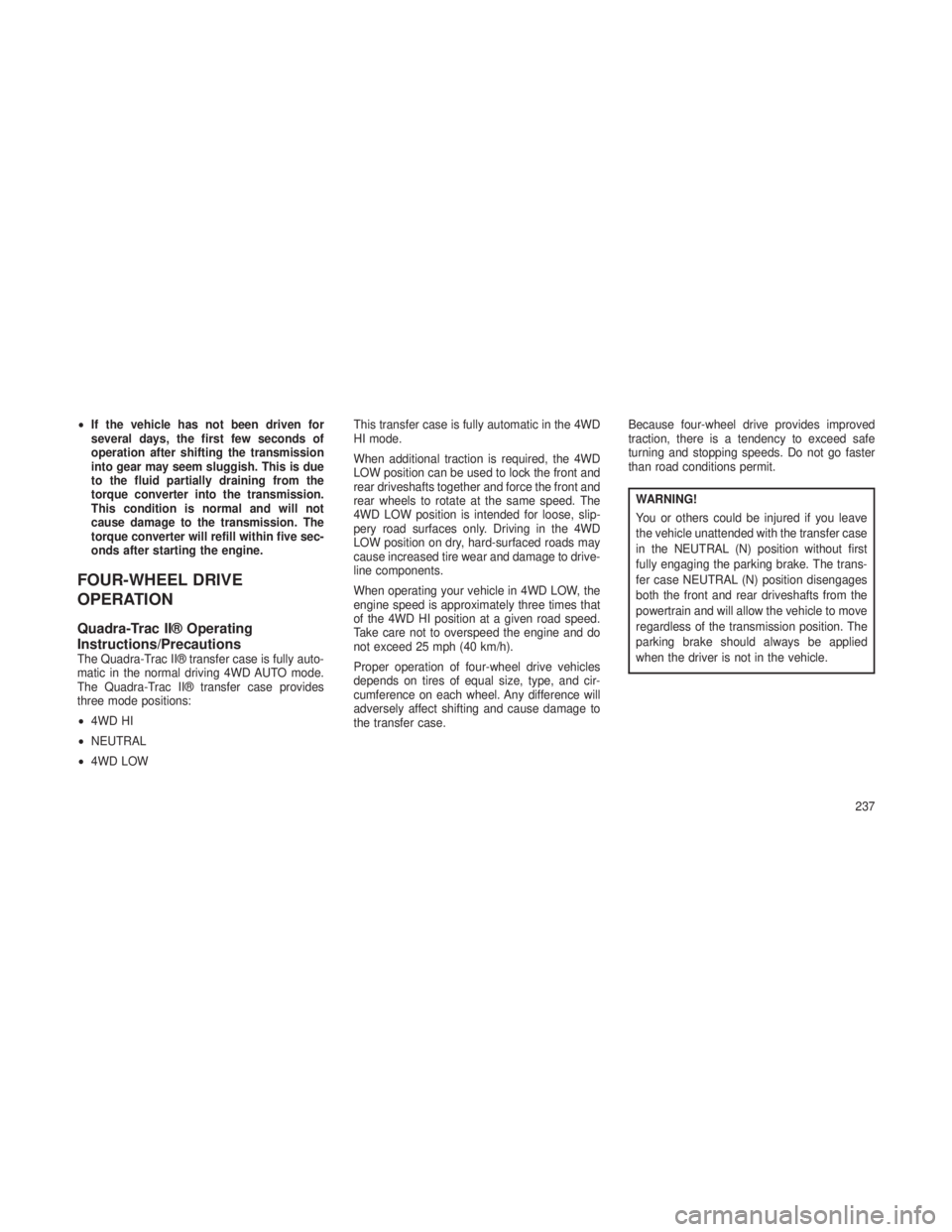
•If the vehicle has not been driven for
several days, the first few seconds of
operation after shifting the transmission
into gear may seem sluggish. This is due
to the fluid partially draining from the
torque converter into the transmission.
This condition is normal and will not
cause damage to the transmission. The
torque converter will refill within five sec-
onds after starting the engine.
FOUR-WHEEL DRIVE
OPERATION
Quadra-Trac II® Operating
Instructions/Precautions
The Quadra-Trac II® transfer case is fully auto-
matic in the normal driving 4WD AUTO mode.
The Quadra-Trac II® transfer case provides
three mode positions:
•4WD HI
• NEUTRAL
• 4WD LOW This transfer case is fully automatic in the 4WD
HI mode.
When additional traction is required, the 4WD
LOW position can be used to lock the front and
rear driveshafts together and force the front and
rear wheels to rotate at the same speed. The
4WD LOW position is intended for loose, slip-
pery road surfaces only. Driving in the 4WD
LOW position on dry, hard-surfaced roads may
cause increased tire wear and damage to drive-
line components.
When operating your vehicle in 4WD LOW, the
engine speed is approximately three times that
of the 4WD HI position at a given road speed.
Take care not to overspeed the engine and do
not exceed 25 mph (40 km/h).
Proper operation of four-wheel drive vehicles
depends on tires of equal size, type, and cir-
cumference on each wheel. Any difference will
adversely affect shifting and cause damage to
the transfer case.
Because four-wheel drive provides improved
traction, there is a tendency to exceed safe
turning and stopping speeds. Do not go faster
than road conditions permit.
WARNING!
You or others could be injured if you leave
the vehicle unattended with the transfer case
in the NEUTRAL (N) position without first
fully engaging the parking brake. The trans-
fer case NEUTRAL (N) position disengages
both the front and rear driveshafts from the
powertrain and will allow the vehicle to move
regardless of the transmission position. The
parking brake should always be applied
when the driver is not in the vehicle.
237
Page 289 of 408
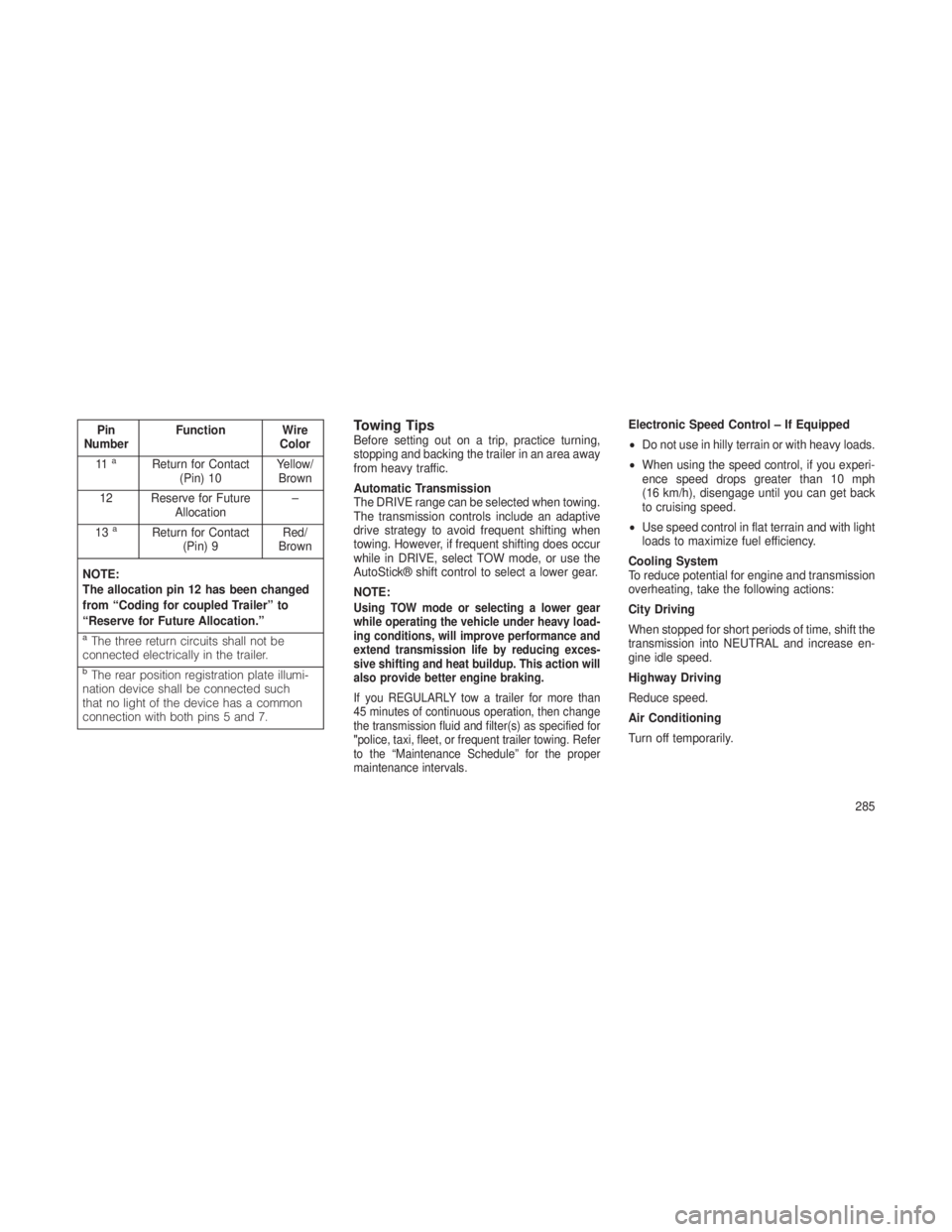
Pin
Number Function Wire
Color
11
aReturn for Contact (Pin) 10 Yellow/
Brown
12 Reserve for Future Allocation –
13
aReturn for Contact (Pin) 9 Red/
Brown
NOTE:
The allocation pin 12 has been changed
from “Coding for coupled Trailer” to
“Reserve for Future Allocation.”
aThe three return circuits shall not be
connected electrically in the trailer.
bThe rear position registration plate illumi-
nation device shall be connected such
that no light of the device has a common
connection with both pins 5 and 7.
Towing TipsBefore setting out on a trip, practice turning,
stopping and backing the trailer in an area away
from heavy traffic.
Automatic Transmission
The DRIVE range can be selected when towing.
The transmission controls include an adaptive
drive strategy to avoid frequent shifting when
towing. However, if frequent shifting does occur
while in DRIVE, select TOW mode, or use the
AutoStick® shift control to select a lower gear.
NOTE:
Using TOW mode or selecting a lower gear
while operating the vehicle under heavy load-
ing conditions, will improve performance and
extend transmission life by reducing exces-
sive shifting and heat buildup. This action will
also provide better engine braking.
If you REGULARLY tow a trailer for more than
45 minutes of continuous operation, then change
the transmission fluid and filter(s) as specified for
"police, taxi, fleet, or frequent trailer towing. Refer
to the “Maintenance Schedule” for the proper
maintenance intervals.
Electronic Speed Control – If Equipped
• Do not use in hilly terrain or with heavy loads.
• When using the speed control, if you experi-
ence speed drops greater than 10 mph
(16 km/h), disengage until you can get back
to cruising speed.
• Use speed control in flat terrain and with light
loads to maximize fuel efficiency.
Cooling System
To reduce potential for engine and transmission
overheating, take the following actions:
City Driving
When stopped for short periods of time, shift the
transmission into NEUTRAL and increase en-
gine idle speed.
Highway Driving
Reduce speed.
Air Conditioning
Turn off temporarily.
285
Page 312 of 408
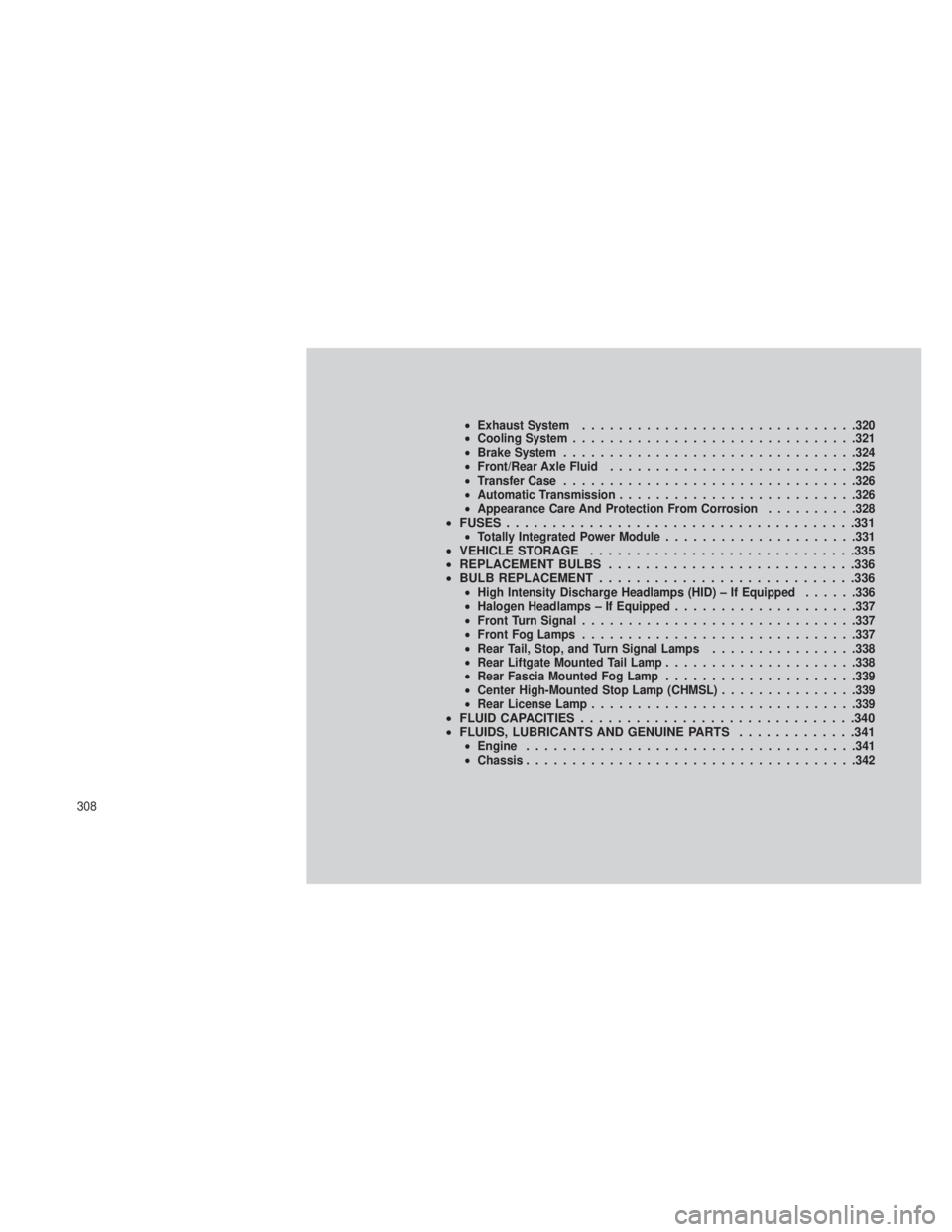
•Exhaust System ............................. .320
• Cooling System .............................. .321
• Brake System ............................... .324
• Front/Rear Axle Fluid .......................... .325
• Transfer Case ............................... .326
• Automatic Transmission ......................... .326
• Appearance Care And Protection From Corrosion ..........328
•FUSES ......................................331•Totally Integrated Power Module .....................331•VEHICLE STORAGE .............................335
• REPLACEMENT BULBS ...........................336
• BULB REPLACEMENT ............................336
•High Intensity Discharge Headlamps (HID) – If Equipped ......336
• Halogen Headlamps – If Equipped ....................337
• Front Turn Signal ............................. .337
• Front Fog Lamps ............................. .337
• Rear Tail, Stop, and Turn Signal Lamps ................338
• Rear Liftgate Mounted Tail Lamp .....................338
• Rear Fascia Mounted Fog Lamp .....................339
• Center High-Mounted Stop Lamp (CHMSL) ...............339
• Rear License Lamp ............................ .339
•FLUID CAPACITIES ..............................340
• FLUIDS, LUBRICANTS AND GENUINE PARTS .............341
•Engine ................................... .341
• Chassis ................................... .342
308
Page 314 of 408
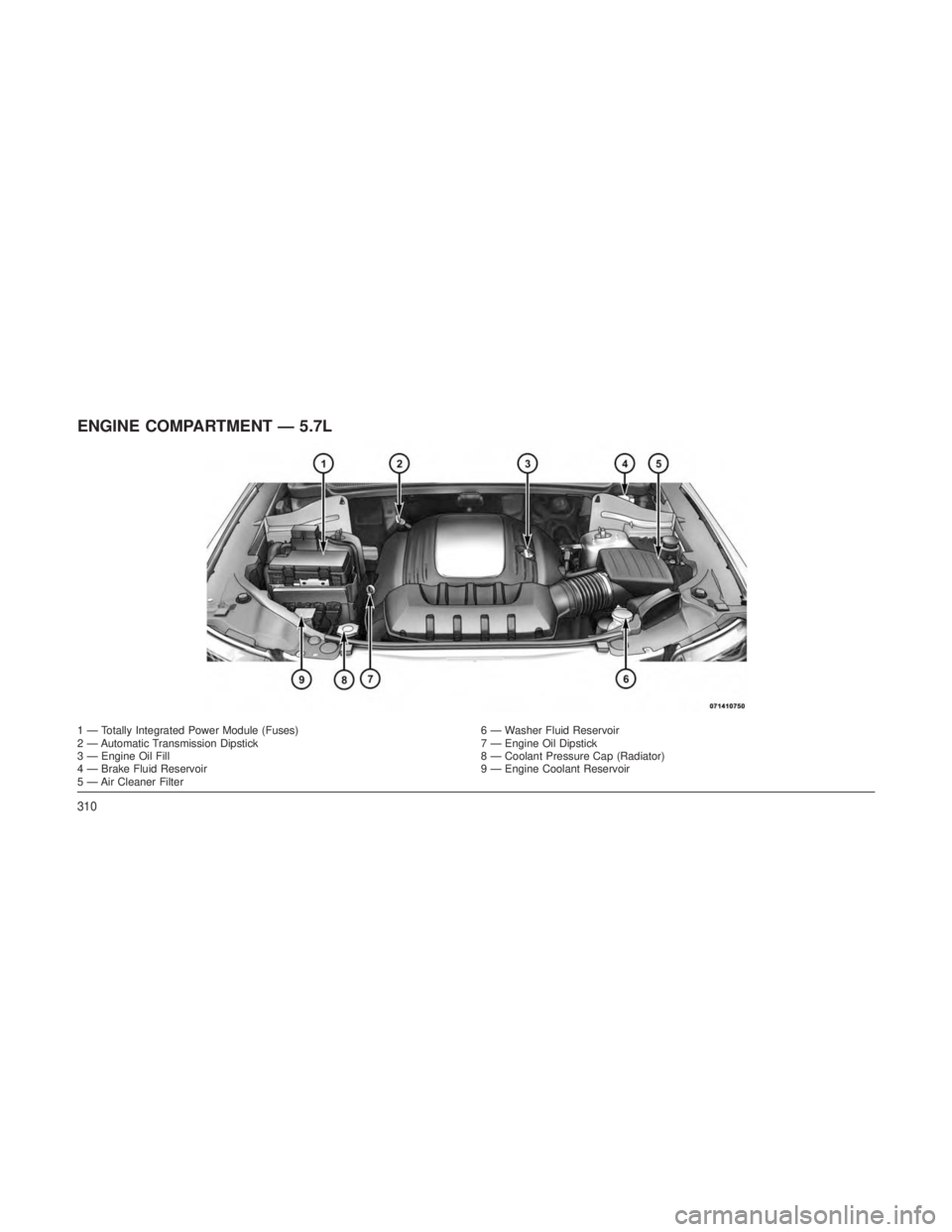
ENGINE COMPARTMENT — 5.7L
1 — Totally Integrated Power Module (Fuses)6 — Washer Fluid Reservoir
2 — Automatic Transmission Dipstick 7 — Engine Oil Dipstick
3 — Engine Oil Fill 8 — Coolant Pressure Cap (Radiator)
4 — Brake Fluid Reservoir 9 — Engine Coolant Reservoir
5 — Air Cleaner Filter
310
Page 330 of 408

The rear axle fill and drain plugs should be
tightened to 22 to 29 ft lbs (30 to 40 N·m) on
axles with aluminum housings. The rear axle fill
and drain plugs should be tightened to 22 to
52 ft lbs (30 to 70 N·m) on axles with cast iron
housings.
CAUTION!
Do not over tighten the plugs as it could
damage then and cause them to leak.
Selection Of Lubricant
Use only the manufacturer’s recommended
fluid. Refer to “Fluids, Lubricants, and Genuine
Parts” in “Maintaining Your Vehicle” for further
information.
Transfer Case
Fluid Level Check
For normal service, periodic fluid level checks
are not required. When the vehicle is serviced
for other reasons the exterior surfaces of the
transfer case assembly should be inspected. If
oil leakage is suspected inspect the fluid level. Refer to “Fluids, Lubricants, and Genuine Parts”
in “Maintaining Your Vehicle” for further informa-
tion.
Adding Fluid
Add fluid at the filler hole, until it runs out of the
hole, when the vehicle is in a level position.
Drain
First remove fill plug, then remove drain plug.
Recommended tightening torque for drain and
fill plugs is 15 to 25 ft lbs (20 to 34 N·m).
CAUTION!
When installing plugs, do not overtighten.
You could damage them and cause them to
leak.
Selection Of Lubricant
Use only the manufacturer’s recommended
fluid. Refer to “Fluids, Lubricants, and Genuine
Parts” in “Maintaining Your Vehicle” for further
information.
Automatic Transmission
Selection Of Lubricant
It is important to use the proper transmission
fluid to ensure optimum transmission perfor-
mance and life. Use only the manufacturer’s
recommended transmission fluid. Refer to “Flu-
ids, Lubricants, and Genuine Parts” in “Main-
taining Your Vehicle” for fluid specifications. It is
important to maintain the transmission fluid at
the correct level using the recommended fluid.
NOTE:
No chemical flushes should be used in any
transmission; only the approved lubricant
should be used.
CAUTION!
Using a transmission fluid other than the
manufacturer’s recommended fluid may cause
deterioration in transmission shift quality
and/or torque converter shudder. Refer to “Flu-
ids, Lubricants, and Genuine Parts” in “Main-
taining Your Vehicle” for fluid specifications.
326
Page 331 of 408
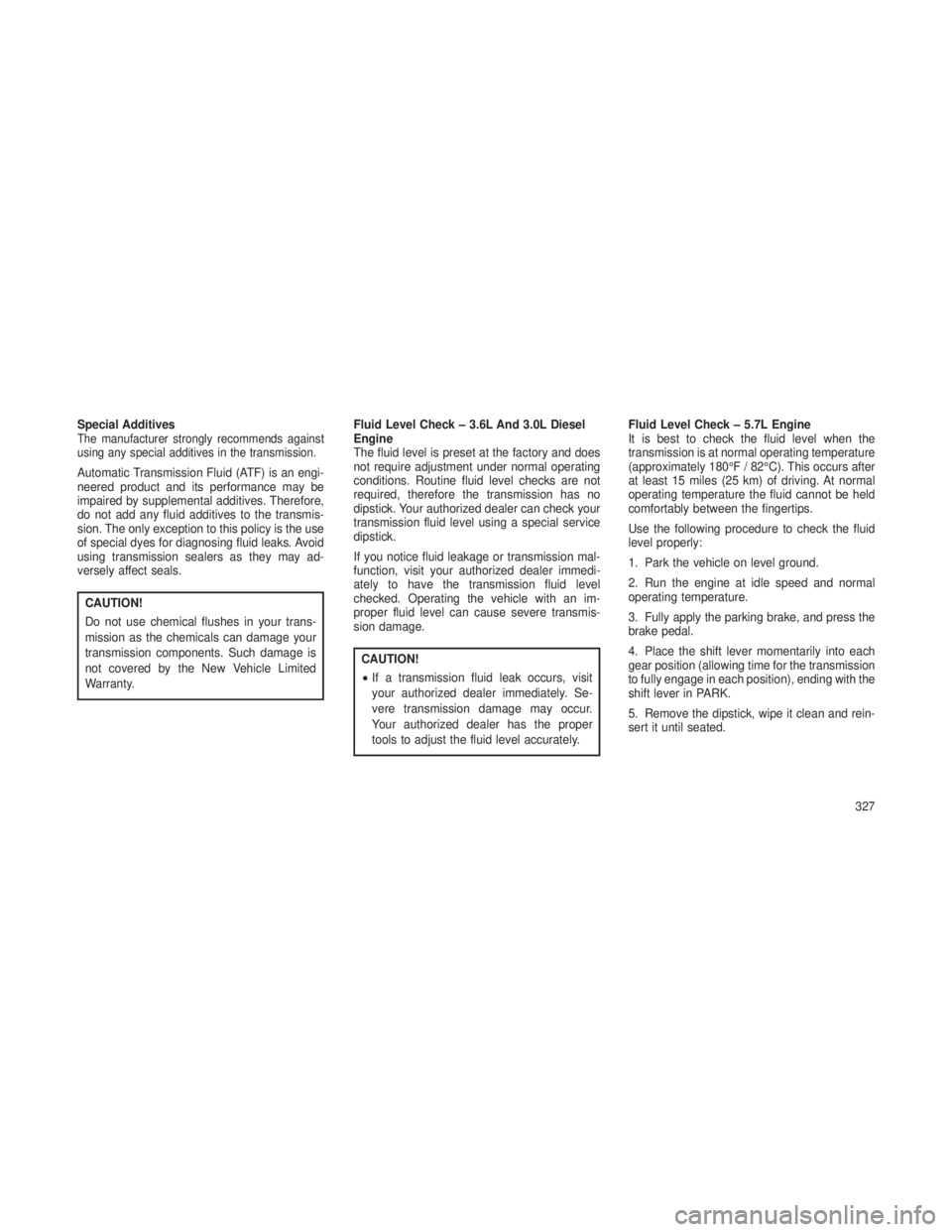
Special AdditivesThe manufacturer strongly recommends against
using any special additives in the transmission.
Automatic Transmission Fluid (ATF) is an engi-
neered product and its performance may be
impaired by supplemental additives. Therefore,
do not add any fluid additives to the transmis-
sion. The only exception to this policy is the use
of special dyes for diagnosing fluid leaks. Avoid
using transmission sealers as they may ad-
versely affect seals.
CAUTION!
Do not use chemical flushes in your trans-
mission as the chemicals can damage your
transmission components. Such damage is
not covered by the New Vehicle Limited
Warranty.Fluid Level Check – 3.6L And 3.0L Diesel
Engine
The fluid level is preset at the factory and does
not require adjustment under normal operating
conditions. Routine fluid level checks are not
required, therefore the transmission has no
dipstick. Your authorized dealer can check your
transmission fluid level using a special service
dipstick.
If you notice fluid leakage or transmission mal-
function, visit your authorized dealer immedi-
ately to have the transmission fluid level
checked. Operating the vehicle with an im-
proper fluid level can cause severe transmis-
sion damage.
CAUTION!
•
If a transmission fluid leak occurs, visit
your authorized dealer immediately. Se-
vere transmission damage may occur.
Your authorized dealer has the proper
tools to adjust the fluid level accurately. Fluid Level Check – 5.7L Engine
It is best to check the fluid level when the
transmission is at normal operating temperature
(approximately 180°F / 82°C). This occurs after
at least 15 miles (25 km) of driving. At normal
operating temperature the fluid cannot be held
comfortably between the fingertips.
Use the following procedure to check the fluid
level properly:
1. Park the vehicle on level ground.
2. Run the engine at idle speed and normal
operating temperature.
3. Fully apply the parking brake, and press the
brake pedal.
4. Place the shift lever momentarily into each
gear position (allowing time for the transmission
to fully engage in each position), ending with the
shift lever in PARK.
5. Remove the dipstick, wipe it clean and rein-
sert it until seated.
327
Page 346 of 408
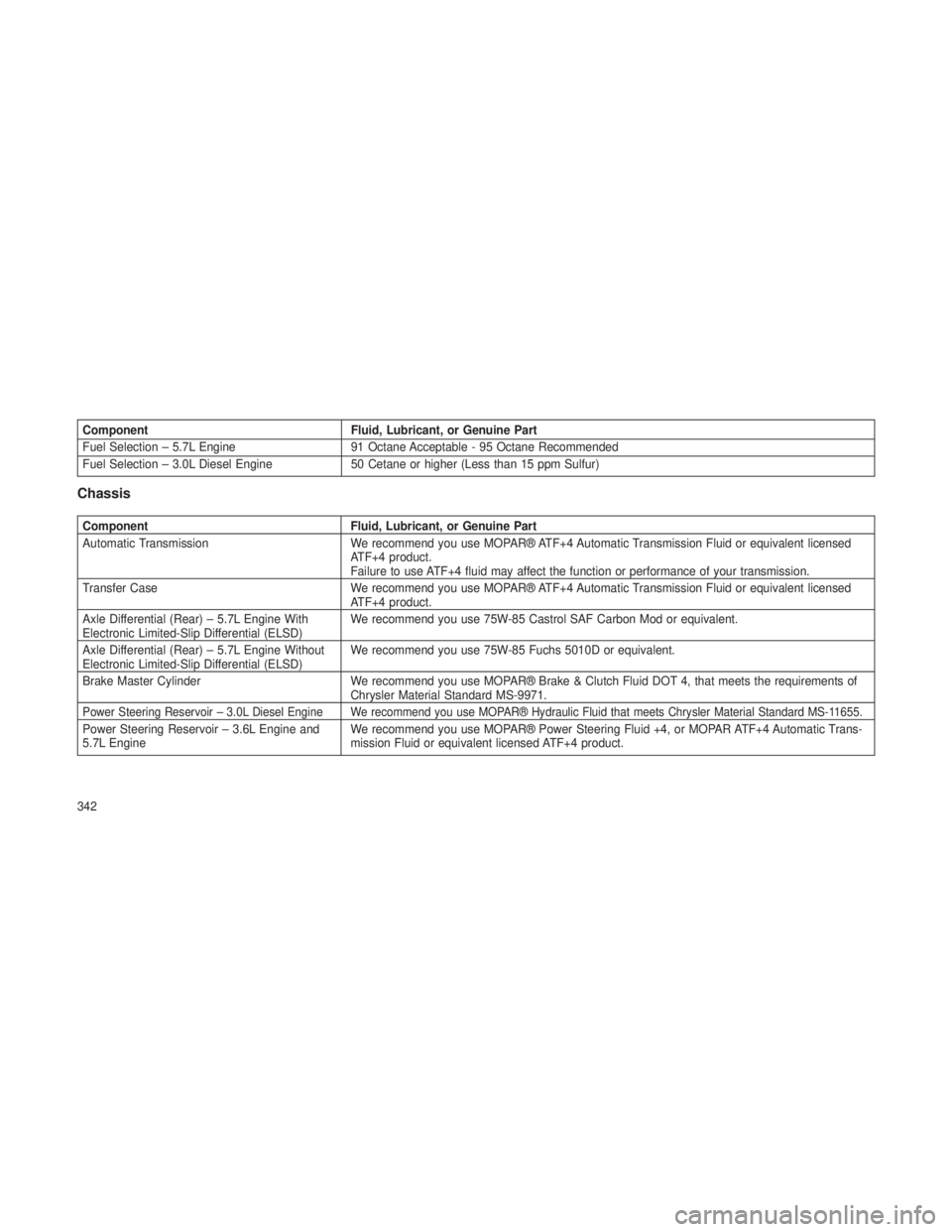
ComponentFluid, Lubricant, or Genuine Part
Fuel Selection – 5.7L Engine 91 Octane Acceptable - 95 Octane Recommended
Fuel Selection – 3.0L Diesel Engine 50 Cetane or higher (Less than 15 ppm Sulfur)
Chassis
ComponentFluid, Lubricant, or Genuine Part
Automatic Transmission We recommend you use MOPAR® ATF+4 Automatic Transmission Fluid or equivalent licensed
ATF+4 product.
Failure to use ATF+4 fluid may affect the function or performance of your transmission.
Transfer Case We recommend you use MOPAR® ATF+4 Automatic Transmission Fluid or equivalent licensed
ATF+4 product.
Axle Differential (Rear) – 5.7L Engine With
Electronic Limited-Slip Differential (ELSD) We recommend you use 75W-85 Castrol SAF Carbon Mod or equivalent.
Axle Differential (Rear) – 5.7L Engine Without
Electronic Limited-Slip Differential (ELSD) We recommend you use 75W-85 Fuchs 5010D or equivalent.
Brake Master Cylinder We recommend you use MOPAR® Brake & Clutch Fluid DOT 4, that meets the requirements of
Chrysler Material Standard MS-9971.
Power Steering Reservoir – 3.0L Diesel Engine We recommend you use MOPAR® Hydraulic Fluid that meets Chrysler Material Standard MS-11655.
Power Steering Reservoir – 3.6L Engine and
5.7L EngineWe recommend you use MOPAR® Power Steering Fluid +4, or MOPAR ATF+4 Automatic Trans-
mission Fluid or equivalent licensed ATF+4 product.
342
Page 354 of 408
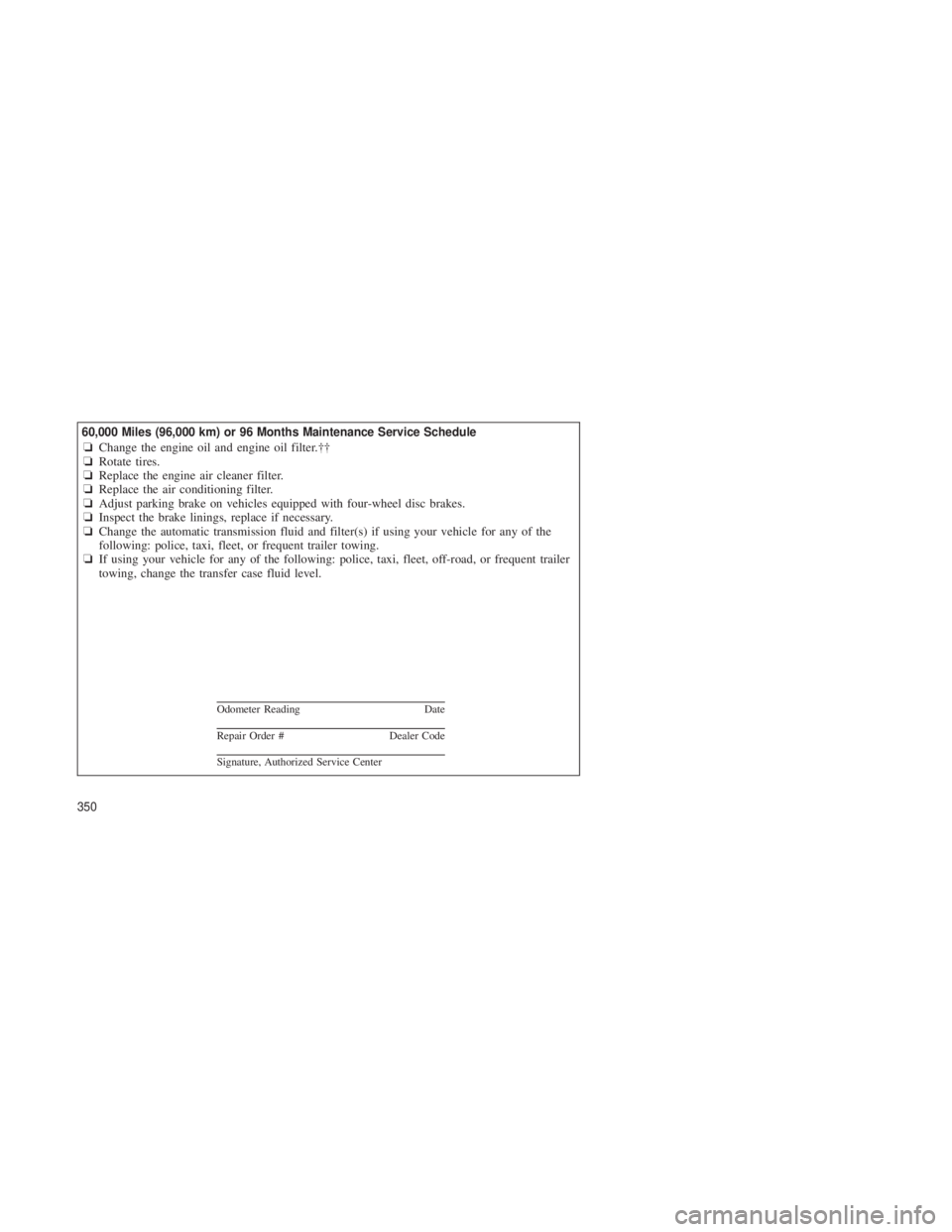
60,000 Miles (96,000 km) or 96 Months Maintenance Service Schedule❏Change the engine oil and engine oil filter.††
❏ Rotate tires.
❏ Replace the engine air cleaner filter.
❏ Replace the air conditioning filter.
❏ Adjust parking brake on vehicles equipped with four-wheel disc brakes.
❏ Inspect the brake linings, replace if necessary.
❏ Change the automatic transmission fluid and filter(s) if using your vehicle for any of the
following: police, taxi, fleet, or frequent trailer towing.
❏ If using your vehicle for any of the following: police, taxi, fleet, off-road, or frequent trailer
towing, change the transfer case fluid level.
Odometer Reading Date
Repair Order #Dealer Code
Signature, Authorized Service Center
350